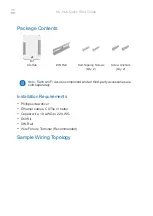
Date Code 990215
Inputs, Outputs, Timers, and Other Control Logic
7-23
SEL-351P Manual Técnico
The function of the SEL
OGIC
Control Equations in Table SECTION 7: .5 becomes more
apparent in the following example scenario.
Start Out in Setting Group 1
Refer to Figure SECTION 7: .20.
The relay has been in setting Group 1 for some time, with timer logic output SV8T asserted to
logical 1, thus enabling SEL
OGIC
Control Equation setting SS4 for the assertion of input IN105.
Switch to Setting Group 4
Refer to Figure SECTION 7: .20.
The SCADA contact pulses input IN105, and the active setting group changes to setting Group 4
after qualifying time setting TGR (perhaps set at a cycle or so to qualify the assertion of setting
SS4). Optoisolated input IN105 also has its own built-in debounce timer (IN105D) available (see
Figure SECTION 7: .1).
Note that Figure SECTION 7: .20 shows both setting Group 1 and setting Group 4 settings. The
setting Group 1 settings (top of Figure SECTION 7: .20) are enabled only when setting Group 1
is the active setting group and likewise for the setting Group 4 settings at the bottom of the
figure.
Setting Group 4 is now the active setting group, and Relay Word bit SG4 asserts to logical 1.
After the relay has been in setting Group 4 for a time period equal to SV8PU, the timer logic
output SV8T asserts to logical 1, thus enabling SEL
OGIC
Control Equation setting SS1 for a new
assertion of input IN105.
Note that input IN105 is still asserted as setting Group 4 is activated. Pickup time SV8PU keeps
the continued assertion of input IN105 from causing the active setting group to revert back again
to setting Group 1 for a single assertion of input IN105. This keeps the active setting group from
being changed at a time interval less than time SV8PU.
Switch Back to Setting Group 1
Refer to Figure SECTION 7: .20.
The SCADA contact pulses input IN105 a second time, and the active setting group changes back
to setting Group 1 after qualifying time setting TGR (perhaps set at a cycle or so to qualify the
assertion of setting SS1). Optoisolated input IN105 also has its own built-in debounce timer
(IN105D) available (see Figure SECTION 7: .1).
Summary of Contents for SEL-351P
Page 6: ......
Page 92: ......
Page 96: ......
Page 154: ......
Page 156: ......
Page 222: ......
Page 258: ......
Page 262: ......
Page 324: ......
Page 368: ......
Page 406: ......
Page 482: ......
Page 534: ......
Page 539: ......
Page 549: ......
Page 551: ......
Page 587: ......
Page 597: ......
Page 601: ......
Page 603: ......
Page 609: ......
Page 621: ......
Page 635: ......
Page 649: ......
Page 665: ......
Page 671: ......
















































